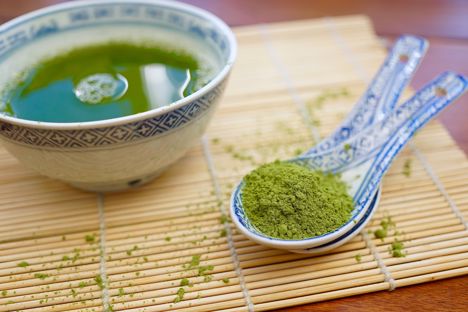
Flavours of Japan: matcha
Elly McCausland guides us through the history and uses of matcha – the Japanese powdered green tea that is making its mark in kitchens around the world.
Flavours of Japan: matcha
Elly McCausland guides us through the history and uses of matcha – the Japanese powdered green tea that is making its mark in kitchens around the world.
If you’ve browsed through a food magazine, food blog or your Instagram feed recently, you may well have seen pots of bright emerald green powder being whisked into lattes, brownies, cupcakes and even guacamole. Despite its vivid appearance, this striking substance is not a form of food colouring beloved by cooks keen to up the camera-friendliness of their food. It’s matcha, a type of tea lauded for its health benefits, refreshing flavour and, as cooks and chefs are finding out, its versatility in the kitchen.
Matcha is, essentially, green tea, but there’s a big difference between this ultra-fine, silky-soft powder and the dark green shavings that fill your standard teabag. Grown mostly in Japan, the green tea leaves used for matcha are kept in the shade, covered to prevent direct sunlight, for three weeks before their harvest, which turns the leaves a darker shade of green due to an increase in chlorophyll levels. Only the finest leaves are chosen, and the stems and veins of the leaves are removed before being stone-ground, resulting in the super-fine powder that is matcha. Its comparatively high cost is due to the laborious and refined nature of this process: it can take up to an hour to grind just thirty grams of matcha. There are different levels of quality: the best matcha is made from the leaves highest up on the tea bush, which are soft and pliable because the plant sends most of its nutrients to the young leaves, giving a finer texture to the resulting matcha. Coarser leaves give a more astringent taste and a darker colour.
As with most tea, matcha originated in China. During the Tang Dynasty, green tea leaves were steamed and formed into bricks for storage and trade, then pounded and roasted to form a powder that could be reconstituted in hot water. During the Song Dynasty, this powdered tea began to be whisked together with hot water in a bowl, the most common way of preparing matcha today. It should be sieved before use to separate out any lumps, then placed into a special bowl or cup and whisked (traditionally with a bamboo whisk) with water of a temperature of 70–85ºC (never boiling). Matcha drinks vary in strength and thickness; thick matcha is known as koicha, and thin as usucha. Matcha was introduced to Japan in the eighth century, where it became a prominent part of traditional tea ceremonies; some of the finest matcha you can buy today is ‘ceremonial grade’, and it is especially popular all over Japan. It’s much more potent than traditional tea varieties, because it is highly concentrated, and consequently has much higher levels of antioxidants than traditional green tea (as well as higher caffeine levels).
Cooking with matcha
Matcha has recently been discovered by adventurous cooks worldwide, and for good reason: its vivid, emerald colour adds interest and visual appeal to an array of dishes, particularly desserts. It has been appropriated by Western cooks for a variety of uses, mostly sweet, such as cookies, pound cakes and popsicles. It combines well with chocolate, its bitterness offsetting any cloyingness, and is also excellent with citrus flavours like lemon and lime, which partner beautifully with its herbal notes. Cakes made with matcha have a wonderful bright green crumb, and work well when incorporating other Asian flavours like black sesame or lychee. In Japan, matcha is often used to flavour delicate, French-style desserts and chiffon cakes, as well as being incorporated into a range of hot and iced beverages. However, matcha is also excellent in savoury recipes, where it brings a subtle herbal and slightly bitter note that counteracts rich foods like oily fish: it can be used to poach salmon fillets or even to smoke cuts of meat and fish, producing a delicate, fragrant smoke that firms and seasons the meat or fish beautifully.
There is far more to tea than a mug and a kettle, and matcha in particular is a fabulous addition to any kitchen cupboard. Its gorgeous colour and refreshing flavour makes it a perfect blueprint for innovative cooks keen to add a small piece of traditional Japanese culture to their recipes – or just a vibrant splash of bright green.

